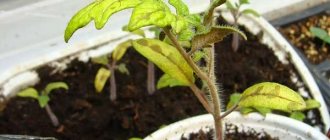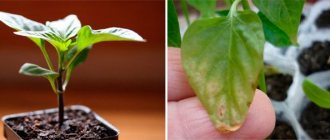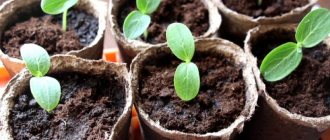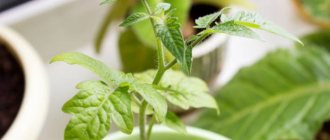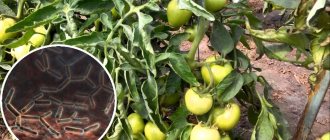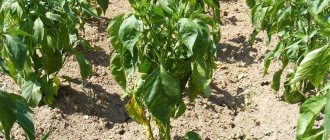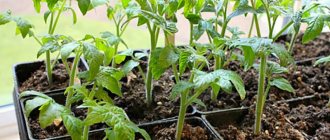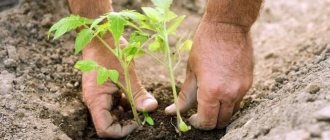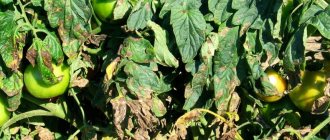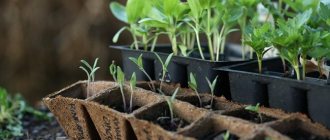Vegetable growing » Tomatoes
0
5447
Article rating
Kira Stoletova
Growing seedlings is a very important stage. Healthy, strong seedlings are well accepted in a permanent location. Plants grow that are capable of producing a good harvest of tomatoes. Sometimes during the growing process something goes wrong and the leaves of tomato seedlings wither. In such a situation, it is important to find the cause and do everything necessary to prevent it from dying.
Leaves of tomato seedlings wither: causes and solutions to the problem
Leaves of tomato seedlings wither: causes and solutions to the problem
Growing seedlings is a very important stage. Healthy, strong seedlings are well accepted in a permanent location. Plants grow that are capable of producing a good harvest of tomatoes. Sometimes during the growing process something goes wrong and the leaves of tomato seedlings wither. In such a situation, it is important to find the cause and do everything necessary to prevent it from dying.
Leaves of tomato seedlings wither: causes and solutions to the problem
The main reasons for plant wilting
In order not to say goodbye to the idea of growing tomatoes in your own garden bed, you must first find out why tomato seedlings wither and fall. By identifying the causes, you can help the plants restore their former health.
Among the main causes of wilting are:
- violations of agricultural technology;
- infection with diseases.
Often it is poor care and oversight during cultivation that causes tomato seedlings to wither. One should also not exclude infection by diseases as a cause of tomato wilting; even such young plants can suffer from this. If you find out in time why the seedlings began to wither, you can improve the situation and saving the young bushes will not be difficult.
Lighting control
Tomato seedlings should grow with at least 12 hours of daylight. The optimal indicator is 16 hours. If sowing was carried out in February - early March, or containers with seedlings are on shelves, then additional lighting is installed.
What happens to seedlings in insufficient light:
seedlings stretch out, become thinner, turn pale, leaves, starting from the lower tier, wither and fall off;
Plant growth slows down and the process of photosynthesis stops.
What to do:
installation of phytolamps for the recommended period of illumination with mandatory rest for at least 8 hours;
growing on south and south-east windows with an additional reflective foil screen.
What happens to seedlings when there is too much light:
burns appear on the leaves in the form of small, almost transparent spots, which reduces the turgor of the leaf blades;
in combination with low air humidity, an excess of light leads to a slowdown in processes in plant tissues, which ultimately causes lethargy and subsequent falling of leaves, starting from the lower tier.
What to do:
compliance with lighting conditions;
installing lamps no closer than 20 cm from the top leaf;
installation of protective screens when growing seedlings in direct sun.
Violation of agricultural technology
Unsuitable soil
Properly selected soil is of great importance. If the seeds are sown in heavy clay soil or it has a low pH level and increased acidity, the young plants begin to wither. And after a while they dry out and die. This is due to the fact that with a heavy compacted soil mixture, gas exchange is disrupted, the root system develops poorly, and the plant does not receive enough nutrients. And a low pH level leads to a high level of salts in the soil, which attract microelements, which does not allow seedlings to receive adequate nutrition.
Solution
In such a situation, the first thing to do is replant it in suitable soil. For tomatoes, well-drained neutral soil with a pH level of 5.5-7 is suitable. The composition should include:
- leaf soil;
- lowland peat;
- agroperlite or vermiculite;
- sand.
You can purchase a universal soil mixture. Before transplanting, it is worth disinfecting it so as not to expose it to the risk of infection. The soil should be spilled with a weak solution of potassium permanganate or cauterized in the oven at 90 °C for half an hour. The sprouts are carefully transplanted into the prepared soil and lightly watered.
Thickened plantings
With ignorance or fear that the seeds may not germinate well, an inexperienced gardener has a desire to plant more seeds in a container. As a result, a large number of tomatoes grow in containers. The plants are crowded, they do not have enough light and space, they begin to stretch out. The stems become thin and the leaves wither.
Solution
Plants need to remove excess greenery
To save tomatoes, it is enough to thin them or pick them. If such a quantity of what has sprouted is not required, then simply cut through the planting, removing weaker plants. In the case when each bush is valuable, then they pick and transplant some of the plants into additional containers.
Insufficient lighting
At the stage of growing seedlings, sufficient lighting is a very important factor. When sowing seeds early in late winter or early spring, lack of light is a very common problem. Since daylight hours are still short, and the growth of healthy seedlings requires at least 8-10 hours of lighting. In poor lighting, the stems become thinner, moisture becomes thinner and nutrients do not move well through the vascular system, and as a result, the lower leaves of the tomatoes begin to wither, and then the rest.
Solution
To improve the situation, you need to keep the tomatoes on the most illuminated windowsill. The south or east side is better. But a greater effect can be achieved if illuminated with photo lamps or fluorescent lamps. They provide lighting that is as close to natural as possible.
Temperature violation
Even though tomatoes love warmth, high temperatures often cause the plants to shut down and die. Temperatures on a windowsill or greenhouse above 35°C can cause irreversible damage.
Temperature drops below 15 °C have no less detrimental effects. When the temperature is low, tomatoes are unable to absorb nutrients. There is a cessation of receipt:
- phosphorus at temperatures below 15 °C;
- nitrogen at temperatures below 10°C.
Solution
It is necessary to adjust the temperature to the optimal temperature for the growth of tomatoes, and it should be within 18-25 ° C.
High temperatures during the growing period of seedlings are rare. But, if overheating occurs, the room where it grows should be ventilated in order to stabilize the temperature or remove the seedlings to a more suitable place.
At low temperatures, provide additional heating. You can move the seedlings to a more suitable place. Make sure there are no drafts, which can also cause a drop in temperature.
Improper watering
Wilting can also be caused by improper watering. Tomatoes are negatively affected by both lack and excess moisture. Even short-term drying out of the soil leads to wilting of the leaves. But a long absence of watering can completely destroy the seedlings.
Overwatering can cause just as much damage. Excess moisture leads not only to lethargy, but also to rotting of the roots. Also, excessive watering promotes the development of pathogens and fungi.
Solution
Improper watering can have a detrimental effect on tomatoes.
If the seedlings have wilted due to insufficient watering, in order to restore them, it will be enough to carefully water them. What you shouldn’t do is water the seedlings too much right away. It is necessary to moisten the soil gradually in several stages. When proper regular watering is resumed, the condition of the plants will completely stabilize.
If the tomatoes have wilted and died due to severe overwatering, proceed as follows:
- Free the sprouts from wet soil
- Replant into slightly moistened fresh soil
- Gently water each plant with a weak solution of magnesium permanganate.
- Treat the leaves with a solution of Epin or another growth stimulant.
Viral pathology
Plants can get these diseases through contaminated soil or insects . Detecting the disease initially is not easy. Serious manifestations of the virus become noticeable only after complete infection. To prevent plants, you need to treat the soil with a slightly diluted solution of manganese or boric acid. One of these viral diseases that occurs very often is “yellow curl”. The vector of the disease is the whitefly.
Symptoms of the virus:
- Low stature of the ovary.
- The appearance of light yellow spots on the leaves.
- Deformation of the plant.
- Lagging of seedlings in development.
- Uneven color of the plant.
The disease has no cure. Affected seedlings subsequently do not bear fruit. To avoid the spread of the virus, it is necessary to remove the diseased sprout. The remaining seedlings need to be treated with mineral oils.
Mosaic pathogen
The disease develops when a plant is infected with a rod-shaped virus. External manifestations :
- Uneven leaf color from dark to light shade.
- The appearance of yellow spots on seedlings.
- Darkening of leaves.
- Drying of the plant.
Diseased tomato seedlings should be removed and burned. The remaining ovaries can be treated with a urea solution.
Important . To prevent many viral diseases, you can water the seedlings with a 5 percent solution of boric acid on the 10th and 17th days after the sprouts appear.
This is what the mosaic on tomato leaves looks like:
Aspermia or seedlessness
Another one of the most common seedling diseases . Externally it appears:
- Weak and thin stem.
- General underdevelopment of the seedling.
- Deformation of the plant.
- Small undeveloped leaves of the ovary.
The disease cannot be cured. Therefore, it is necessary to remove diseased seedlings and disinfect the remaining plants with a solution of potassium permanganate or slightly diluted urea. Also, you should thoroughly disinfect the soil before planting seeds. In addition, you need to keep the seedlings clean and monitor the humidity of the air and soil. Possible consequences of the virus :
- An infected plant does not bear fruit well.
- Tomato fruits are small in size.
- Deformation of vegetables.
- Lack of seeds in affected tomatoes (which is the main feature of the disease).
Streak
The disease is caused by the tobacco mosaic virus. Its external symptoms:
- The appearance of brown streaks on the stem and leaves.
- Formation of ulcers at the site of strokes.
- Dying of the upper part of the seedling.
- Loss of ovary leaves.
As a rule, the disease does not destroy the entire sprout . For treatment, only the affected part of the plant can be removed. Then treat the tomato and soil with a 5-10 percent solution of potassium permanganate. It is advisable to disinfect the roots of the seedlings with the same solution. This will slow down the development of the seedling, but will completely cure it of the virus. The disease can cause:
- Reduced tomato yield.
- Deterioration in fruit quality.
- Weak vitality of the vegetable.
Infection with diseases
Tomatoes at the seedling stage can also be affected by diseases. The cause of infection is seeds or soil. And not proper care stimulates their development. The most common cause of leaf wilting is the following diseases:
Fusarium wilt (fusarium wilt)
A fungal disease that affects both adult bushes and young seedlings. The causative agent of fusarium is fungal bacteria of the genus Fusarium. Infection occurs through spores that remain viable in the soil for several years. With fusarium, the root is primarily affected and as a result, you can observe that the seedlings become lethargic and fall.
Solution
The disease is complex and the fight against it does not always bring positive results. If fusarium is diagnosed, tomatoes are treated with Trichodermin. Spray the solution over the leaf. They also spill soil on them. Treatment is carried out 2-3 times, every 10 days.
Drying foliage
Tomato leaves dry out for several reasons:
- Deep root damage. In this case, the plant cannot be helped in any way. It is removed.
- Dry air. It is necessary to humidify the air regularly. To do this, use a humidifier or place containers with water next to the seedlings.
- There is not enough moisture in the ground. If lumps or crusts have formed on the soil, you need to increase watering.
- Excessive watering. In this case, rotting of the roots is observed. Such seedlings should be thrown away.
- Soil salinity. Remove the top layer of soil and add a new one. It is also necessary to reduce feeding for several weeks.
Reasons for wilting of tomato seedlings at home
Before applying rehabilitation measures, it is necessary to find out why tomato seedlings do not grow at home, why tomato seedlings wither and fall, that is, to reliably verify why the leaves of tomato seedlings wither, what is the root cause of this. So, the tomato seedlings are falling - the reasons are described below.
Unsuitable soil: methods of disinfection
The first reason why tomato seedlings do not grow at home is acidic, dense soil. The seedlings need to be transplanted into another soil, otherwise they will turn yellow, fall and die. The soil for replanting (and store soil too) must be disinfected in order to destroy pests and pathogens.
There are several methods of disinfection: you can spill the soil with boiling water or a solution of potassium permanganate, freeze it or ignite it. This must be done, since pests in the soil can cause the death of seedlings.
Planting density of planting material
The second reason why tomato seedlings wither is the density of the plantings. Perhaps the plants are crowded, which is why they die. When planting tomatoes, the following distances must be observed: row spacing - 5 cm, between plants in a row - 2 cm.
Picking tomato seedlings
Tomato seedlings fall due to their density - what to do in this case with the seedlings so that they do not die? Unpick and sprinkle the vacated row spaces with sand or ash to prevent blackleg. After picking, tomato seedlings may remain lethargic for 2-3 days, this is normal.
The main reason why tomato seedlings fall after picking is incorrect picking. There are several picking rules:
- Seedlings are picked when 3 true leaves appear on them.
- To form a strong root system, you need to pinch the longest central root by 1/3. If this is not done, the root system will remain undeveloped, and the transplanted seedling will stop growing and turn yellow.
- Before picking, you need to thoroughly water the tomato seedlings and carefully remove them along with a lump of earth, without damaging the roots.
- When replanting, you need to make a deep hole so that the long roots do not bend, otherwise the plant will begin to turn yellow.
- You need to carefully monitor the composition of the soil and replant plants only in the right soil.
Excess moisture in tomato seedlings
If the cotyledon leaves of the transplanted plants begin to turn yellow and fall off, then the tomato seedlings are suffering from excess moisture. After picking, the seedlings’ need for water decreases, which means you shouldn’t water them for 2-3 days. It is best to plant plants in a transparent plastic container, making not only a drainage hole at the bottom, but also in the side walls. This is necessary to ensure that the roots are saturated with oxygen, since plastic does not breathe.
Improper watering of seedlings
The third thing you need to pay attention to is watering the seedlings. Tomatoes are moisture-loving plants. But excessive watering mortally harms them: the roots rot, the tomato seedlings wither, stop growing, the leaves turn yellow, curl up, a moldy smell appears, the tomato seedlings fall and die.
So how to save tomato seedlings from wilting after overwatering? To avoid unpleasant consequences from excessive watering even at the stage when the leaves have just wilted and curled, you need to turn over the container in which the seedlings are growing and check for a drainage hole.
If there is no drainage hole, you need to make one immediately. If it is, it is necessary to thoroughly clean it; perhaps the hole is clogged and therefore does not release excess water.
One drainage hole is necessary in each container with seedlings, since the roots of the tomato must breathe, saturating the entire plant with oxygen. Excess water drains away without harming the tomato seedlings. Otherwise, the roots will rot, which will inevitably lead to the development of bacteria and pests in the soil, and the seedlings will turn yellow, rot, fall and inevitably die.
Lack of moisture in tomato seedlings
Lack of moisture also leads to the death of seedlings.
If the soil in a container with tomatoes is dry and crumbly, it means that the tomato seedlings are dying from insufficient watering, which is why the tomatoes have wilted; you cannot immediately water them abundantly. Dried seedlings should be watered during the day with no more than a tablespoon per root, being careful not to overwater, otherwise the seedlings will turn yellow from excess moisture. It is necessary to water tomato seedlings regularly, abundantly, but only after the top layer of soil has dried. Excess water will flow out through the drain hole.
To ensure access of oxygen to the roots of plants, so that the leaves of tomatoes do not dry out, it is also necessary to regularly carry out dry watering, namely: loosen the soil in a container with tomato seedlings every day.
Lack or excess of light
The fourth reason why tomato seedlings fall and the leaves of tomato seedlings wither is the lack of light.
Tomatoes must be illuminated for at least 12 hours a day. To prevent the seedlings from dying, it is necessary to illuminate them with phytolamps. Otherwise, the seedlings will stretch, become tall, thin, fall and die. Excess light also negatively affects the development of seedlings, the leaves begin to burn, wither, turn yellow, and the plant dies. There is no need to illuminate the seedlings at night; it is in the dark that the plants absorb nutrients.
Failure to comply with temperature conditions
The fifth reason why tomato seedlings die on the windowsill is non-compliance with the temperature regime.
Methods to prevent the problem
Let's summarize briefly. Ways to save tomatoes are:
- Before planting seeds, they should be disinfected;
- plant in special soil prepared in advance;
- monitor optimal irrigation of seedlings;
- place the seedlings at home in a room with the longest natural light during the day;
- ensure favorable conditions for temperature, humidity and air circulation indoors.
Caring for tomato seedlings and subsequently obtaining a rich harvest is not an easy task. It is important to follow the recommendations given and competently organize the upcoming work.
Seedlings on the windowsill of an apartment
In general, a windowsill is not an ideal place to grow tomato seedlings.
Even from a closed window, it blows into the cracks, the plants become overcooled, the leaves turn yellow due to the draft, so the tomato seedlings on the window wither, they may even die due to non-compliance with the temperature regime. Before growing tomato seedlings on the windowsill, you need to seal all the cracks or cover the windows with paper. You cannot open the window - the plants will be destroyed by the cold wind.
It is not recommended to grow seedlings on window sills facing north, as they will wither and turn yellow from lack of light and excess cold air. In the best case, the seedlings will stop growing, in the worst case, they will weaken and fall, so it is better to move them from the windowsill to the table away from drafts, using artificial supplementary lighting.
You should not leave seedlings on windowsills facing south; direct rays of the sun harm the delicate stems and leaves of plants, they burn them, seedlings die from overheating, which is the main reason why tomato seedlings wither on a windowsill - they burn in the sun.
Feeding tomato seedlings
The next reason that the seedlings began to turn yellow is the lack of nutrients in the soil.
To do this, the plant must be fed properly. We should not forget that an overabundance of fertilizers can cause not only burns to the roots of tomatoes, which will inevitably lead to the death of seedlings, but can spoil the top layer of soil, turning it into a hard whitish crust that blocks the access of oxygen to the roots of plants.
This crust needs to be removed and the tomato seedlings watered with a weak solution of humate for several days. It will help restore the soil and stimulate further seedling growth.
Use of chemicals
The drugs help prevent crop diseases, stop the proliferation of fungi and microbes that cause infections, and also save plants from insect invasion. Anti-stress agents are used after seedlings have been picked to help the bushes adapt to a new place. The following medications are found in a gardener's home medicine cabinet:
- MikoHelp, Fitosporin, Maxim, Glyokladin - means for pre-sowing irrigation of the substrate; seed treatment; treatment of seedlings. Substances quickly penetrate through the capillaries into the cells of the seedling. To prevent infections, watering is carried out 1 - 2 times.
- Zircon, Atlet, Kornevin strengthen roots and stop the growth of elongated tomatoes.
- Epin has an anti-stress effect (foliar treatment is carried out after transplantation). Watering with solutions of humate and succinic acid will help restore lost strength.
Diseases of tomato seedlings
Other reasons why cotyledon leaves of tomato seedlings wither are diseases. If seedlings are infected with diseases, it is very difficult to save them from death. If the soil was not disinfected before planting, and the leaves on the tomato seedlings began to dry out and fall off, and dark brown veins appeared on the root part of the plant, this means fusarium.
Fusarium blight of tomato seedlings
Fusarium is a fungal disease of plants.
It affects not only tomatoes, but also cucumbers, peas, corn, wheat and many other plants. Tomato fusarium affects the vascular system of seedlings. The disease manifests itself as follows: first, the lower leaves of the tomato seedlings wither, then all the leaves and the top of the seedling turn yellow.
If the plant has not turned yellow at all, it can still be saved by transplanting it into another container using disinfected soil.
If the plant turns yellow from root to top, you will have to mercilessly throw away the seedling so that it does not infect healthy plants.
Black leg of tomato
Another dangerous bacterial disease (not only tomatoes suffer from it) is blackleg.
The black leg of tomatoes is the main reason why seedlings fall as if decimated. Signs of a black leg: the root collar at the base of the stem rots, the leaves turn yellow and fall off, the plant droops, withers and falls.
So what to do if tomato seedlings wither due to black stem? It will not be possible to save plants affected by blackleg; they must be removed and destroyed. Otherwise, they will infect the entire seedling, since the disease is transmitted very easily from one plant to another.
To prevent infection of healthy tomato seedlings with blackleg, it is necessary to disinfect the soil with a solution of potassium permanganate before planting.
Rot in home seedlings
From excess moisture and lack of heat, a disease such as rot can occur - the leaves of plants affected by rot turn yellow, fall off, the plants rot and fall.
It is not possible to save such seedlings at home. It needs to be uprooted and thrown away, healthy ones should be transplanted into another container and strictly observe the watering regime and temperature regime.
This article discusses the main reasons why tomato seedlings in boxes fall. To avoid this kind of trouble, you need to follow all the necessary rules for caring for tomato seedlings.
Correction of diet
The cause of leaf wilting on tomato seedlings is often an imbalance of micro and macroelements in the diet:
- with a lack of nitrogen, the lower, older leaves turn yellow and wither;
- lack of calcium, chlorine, boron, manganese or iron leads to yellowness and wilting of the top;
- A small amount of phosphorus in the soil is the reason for the purple tint of the leaves. The loss of turgor comes from the lower tier;
- potassium deficiency causes curling of the apical leaves, as well as lethargy and dryness of the old leaf blades of the lower tier;
- lack of magnesium - yellowing of leaf blades between the veins, weak turgor, rapid wilting of leaves between waterings;
- zinc deficiency leads to damage to young leaves, which become covered with small yellow spots and wither;
- lack of calcium affects the development of the root system. The result is a lack of nutrition and a slowdown in processes in the tissues of the aerial parts.
Reasons why tomato seedlings fall
There are quite a few reasons for tomatoes withering and falling, and each of them needs to be dealt with separately. Most often this happens due to illness, improper care, or violation of picking rules.
Diseases
If the seedlings wither and fall, this may be due to a seedling disease. Diseases appear due to improper care, pest damage or poor-quality soil. The most common causes of wilting and falling of seedlings are diseases such as fusarium and black leg.
Improper care
In addition to diseases, the reason for the fall of seedlings can be the density of seedlings. With abundant crops, growing plants lack nutrients, moisture and oxygen. The optimal distance between seeds is 3-5 centimeters.
Seedlings need regular and moderate watering. When the soil is overwatered, it turns sour, the plants stretch upward, the leaves turn yellow and wither. The seedlings subsequently fall. With a lack of moisture, plants also wither, fall, and then die. In both cases, they develop a lack of nutrients.
Tomato seedlings are afraid of direct sunlight and excess light, from which the plant leaves can not only wither, but also burn. Containers with plants should not be placed on very heated window sills. Daylight hours should not exceed 12 hours.
Seedlings often fall due to high temperatures that rise to 35 degrees or more. Gradually, the plants overheat and begin to wither. Containers with seedlings should not be placed near heating devices or devices that emit heat.
Low temperatures also negatively affect tomatoes. If the air temperature in the room drops to 15 degrees, the plants stop growing, stop developing, and begin to wither.
Seedlings in containers may fail due to a lack of mineral and organic fertilizers required for development.
With an excess of nitrogen, the stem becomes sour and the root system burns. If fertilized incorrectly, a dense whitish crust appears on the soil surface.
After the pick
If seedlings fall after picking, the reason for this may be the composition of the soil or improper replanting or lack of hardening of the seedlings before replanting. Tomatoes do not develop well in heavy acidic or alkaline soil.
Development of an irrigation regime
When growing tomato seedlings, the watering regime is set individually based on the actual conditions in the room where the seedlings are located.
What happens to tomato seedlings when overwatered:
when overwatering, fungal diseases develop in the root zone, which is why the plant does not receive the required amount of nutrients, breathing in the tissues is impaired, and the leaves quickly wither;
stagnation of moisture when watering in a container without drainage holes leads to a greenhouse effect in the root zone, which reduces the turgor of the green mass.
How to fix the situation:
sowing seeds only in containers with drainage holes;
stop watering until the top layer of soil dries;
loosening after each watering;
using sphagnum moss, which will absorb excess moisture.
What happens to seedlings when the watering regime is violated:
- Watering with cold water causes stress in seedlings. Leaves wither and fall;
- alternating cold and warm water when watering causes the growth of seedlings to stop;
- watering with unsettled tap water disrupts the salt balance, which leads to compaction of the soil, as a result of which nutrition is disrupted and the process of photosynthesis stops;
- spraying seedlings with droplets falling on the leaves leads to the development of fungal diseases;
- watering with boiled or distilled water causes leaching of useful substances from the soil, as a result of which plant nutrition is disrupted;
- Regular treatment of the soil with a manganese solution leads to chlorosis.
What to do:
- water the seedlings with settled water at room temperature;
- moisturizing without overflowing: once every 4-5 days in sunny weather and once every 7-8 days in cloudy weather;
- correction of the watering regime depending on the air humidity in the room where the seedlings are located.
What to do, how to help tomatoes
If diseases appear on seedlings, you need to act immediately.
Fusarium appears due to insufficient disinfection or complete lack of treatment of the soil and container where the seedlings grow. Plants dry out even with regular watering. Fungi attack the roots, depriving the stems of the necessary nutrition.
The roots of the plant are removed from the ground and carefully examined. On large seedlings, the vessels in the lower part of the stem become dark brown in color. Heavily infected seedlings with wilted roots and leaves are removed.
To eliminate the disease at the initial stage, the seedlings are treated twice with Fundazol (10 grams per 10 liters of water) and transplanted into new soil disinfected with potassium permanganate. It is very important to disinfect the seedling container into which it will be transplanted.
Blackleg develops when water stagnates. The roots rot, which leads to the death of the plants. The first sign of the disease is blackening of the stems at the root collar.
The disease is difficult to treat; affected plants almost all die. At the initial stage of damage, the seedlings are transplanted into new soil treated with potassium permanganate. Before planting, the roots are treated with crushed charcoal or ash.
The disease can be prevented with the help of preventive measures. When planting, the soil is disinfected with a solution of potassium permanganate. A good option is store-bought ready-made soil mixture. After watering, the soil is sprinkled with sand.
When the seedlings are dense, seedlings are picked.
After thinning, the space between the sprouts is filled with a small amount of disinfected river sand. 3 days after picking, the seedlings recover and begin to grow.
What is a black leg and how to deal with it: video
If the soil is highly acidic, tomato seedlings can be saved only after replanting the plants in a soil mixture deoxidized with wood ash.
Alkaline soil is replaced with fresh soil with the addition of dolomite flour.
Holes are pre-made at the bottom of the containers, which allow excess water to flow out into the trays. The accumulated moisture in the trays is poured out. The holes are cleared of soil once every 2 weeks. When moisture stagnates in the soil, the seedlings are not watered at first, and then irrigated with a spray bottle.
Lack of moisture also negatively affects seedlings. Overdried soil crumbles and the supply of nutrients to the root system stops.
The first sign of lack of moisture is the wilting of seedlings. If the watering regime is not restored in time, the leaves begin to dry, which leads to the death of the sprouts. To restore nutrition, seedlings are watered with a small amount of water. Approximately 30 milliliters of water is consumed per plant.
Additional illumination of seedlings is carried out in the evening and morning hours, and, if necessary, during the day if the day is cloudy. The lamp should not be turned on at night, as this may harm the plants.
With complex fertilizing, phosphorus, nitrogen, and potassium are applied at least 2 times during the development of seedlings, in accordance with the norm. Phosphorus fertilizers are applied a week before transplanting seedlings to a permanent place of growth. All fertilizers are applied in liquid form.
If there is an excess of nitrogen, the dense whitish film on the surface of the earth is removed, and the soil is watered for some time with a solution of sodium humate (15 grams of the drug per bucket of water).
When transplanting seedlings to a permanent place, the seedlings often wither and fall. To prevent this from happening, the plants are pre-hardened. To do this, at night they are placed in a cooler room, without drafts. Ventilation of the room is carried out without seedlings. In stable warm weather, it is placed outside and brought back indoors in the evening. If there is a greenhouse, plants are sent there around the clock.
Prevention measures
Tomato wilting can be avoided by treating the seeds and soil before sowing. The following techniques can also help prevent trouble:
- improve the structure of the soil mixture - add loosening components - coconut substrate, vermiculite, perlite;
- create a thick layer of drainage, regularly loosen the soil to prevent stagnation of liquid, development of root rot, and proliferation of pests;
- the bushes are irrigated when the top layer of the substrate dries 20 mm;
- carefully monitor air temperature and humidity;
- Before planting in the garden, seedlings are hardened off so that the plants can more easily adapt to new conditions; a week before transplantation, the boxes begin to be taken out onto the balcony - first for an hour, then the time spent in the air is increased;
- After planting, the seedlings are shaded with covering material to reduce stress and help them take root in a new place.
In the garden, before planting bushes, the soil is disinfected. Maintain crop rotation. The best crop predecessors are beans, peas, cabbage, cucumbers, and zucchini.
Additional Information! When growing tomatoes in different situations, potassium permanganate is useful - a proven home remedy. Sow seeds pickled in a manganese solution. The soil is disinfected with raspberry liquid; feed and treat seedlings. When planting grown plants in the ground, the holes are watered with a strong solution of the substance.
Conditions for the growth of healthy tomato seedlings
To grow strong, healthy seedlings, you need to adhere to certain conditions.
To sow seeds and plant tomato seedlings, it is better to take soil mixture purchased at a flower shop. Self-prepared soil, consisting of soil, peat, rotted humus and river sand in proportions 1.5: 1: 1: 0.5. Superphosphate, urea and potash fertilizers are added to the prepared mixture.
The soil mixture must be treated with potassium permanganate or calcined in the oven. For looseness and better moisture permeability, river sand must be added to it.
Before sowing, seeds are treated for 3 hours with immunostimulating drugs, for example Immunocytophyte (a tablet of the drug for 15 grams of water per 5 grams of seeds).
When sowing seeds in prepared soil, they are placed at an equal distance from each other (3-5 centimeters). If possible, they are seated immediately in separate containers or peat tablets.
Picking seedlings is carried out when 2-3 main leaves appear on the sprouts. When transplanting, the main root is pinched, this makes it easier for the seedlings to endure the transplant.
The crops are watered with warm water, after which the sprouts are removed from the soil. During picking, the tips of the roots of the seedlings are pinched off to develop the root system. The seedlings are placed in the holes, the roots are straightened and sprinkled with soil.
If picking is carried out indoors, then the container with seedlings is moved to a heat source, for example, to a heating radiator or air heater to remove excess moisture after transplantation.
If seedlings are picked in a greenhouse, then you can get rid of excess moisture by sprinkling the ground with dry sand or dry sawdust. Sand (sawdust) will absorb moisture within 1 hour, after which it is carefully removed from the beds. The greenhouse must not be ventilated!
Watering the seedlings should be regular and with sufficient water. After watering, the soil is loosened with a thin stick, this helps saturate the roots of the seedlings with oxygen.
To ensure that the seedlings do not become lethargic, they are provided with stable air and soil temperatures and the required amount of light.
Plants are placed in a room with an air temperature of 20-22 degrees.
Only hatched seedlings are provided with round-the-clock lighting. Plants that are gaining strength need bright light 12 hours a day. This time is enough for them to be fully saturated with nutrients.
To feed tomato seedlings, take 0.5 liters of mullein infusion or chicken droppings and 100 grams of wood ash per bucket of water. Feeding is repeated after 10 days.
You can use the following solution: 30 grams of superphosphate, 20 grams of potassium sulfate, 10 grams of ammonium nitrate per bucket of warm water.
A solution is also used: 40 grams of superphosphate, 25 grams of potassium sulfate per 10 liters of water.
Observing all the conditions, the seedlings grow, become stronger and, when transplanted to a permanent place, quickly take root and grow.
How to grow strong tomato seedlings before picking: video
Every gardener should know the basic rules for caring for tomato seedlings. They allow you to protect plants from any ailments, including wilting, falling and possible death. Timely assistance to plants in case of any problem allows them to quickly recover, and prevention completely avoids growing difficulties, guaranteeing plant health and, later, a good harvest.
Sources:
https://fermoved.ru/pomidoryi/pochemu-vyanut-listya-u-rassady.html https://letnyayadacha.ru/ogorod/ovoshhi/pomidory/bolezni-tomatov/pochemu-rassada-pomidor-vyanet-i-padaet -v-domashnih-usloviyah.html https://dom-dacha-sad.ru/pochemu-rassada-pomidor-vyanet-i-padaet.html
How to help plants
At the initial stages of the development of problems, plants can be given “first aid”.
Timely measures will allow the seedlings to recover and continue development.
How to adjust watering
The soil in seedling containers should be constantly moist, but not wet. Watering is carried out regularly, but with a moderate amount of water. A large number of drainage holes helps prevent waterlogging. If tomatoes grow in plastic containers, they are additionally placed on the walls.
Expert opinion
Chernyaeva Tatyana Dmitrievna
Absolutely loves gardening and grows only organic vegetables
Ask a Question
A new portion of water is added to the soil after the top layer has dried by 2–3 cm.
How to balance fertilizing
You can determine which nutrients the seedlings lack by the color of the above-ground parts:
- If the lower, oldest leaves turn yellow, the plants do not have enough magnesium. For feeding 1 liter. add 1.5 - 2 g of magnesium sulfate to water.
- If the seedlings begin to stretch out and turn yellow, it means that it is necessary to limit the supply of nitrogen to the roots. Replacing the top layer will help reduce its concentration in the soil. Half the contents of the seedling containers are removed and fresh soil mixed with a small amount of sawdust is added. Alternatively, you can transplant the plants into new soil and after 10 days spray them with Epin.
- If the leaves are small and yellowish, the plants are lacking nitrogen. The addition of any organic fertilizer helps balance the diet.
- If the leaves have acquired a reddish or bluish tint, it means that the seedlings do not have enough phosphorus. In this case, the seedlings are fed with potassium monophosphate - 2 g per 1 liter. water.
- If the leaves turn white but the veins remain green, the plants lack iron. The seedlings need to be watered with iron sulfate (1% concentration solution).
Treatment of diseases
If seedlings are infected with a fungus, immediate transplantation into fresh soil and treatment with disinfectants is required. Watering with a pale pink solution of potassium permanganate or hydrogen peroxide (2 tsp per 1 liter of water) is effective.
You can also destroy the developing fungus with special preparations:
Hom
Profit Gold
Bravo
Fitosporin
Preventive spraying of foliage with Trichodermin helps prevent infection of seedlings by fungal diseases - 2 times with an interval of 14 days.

